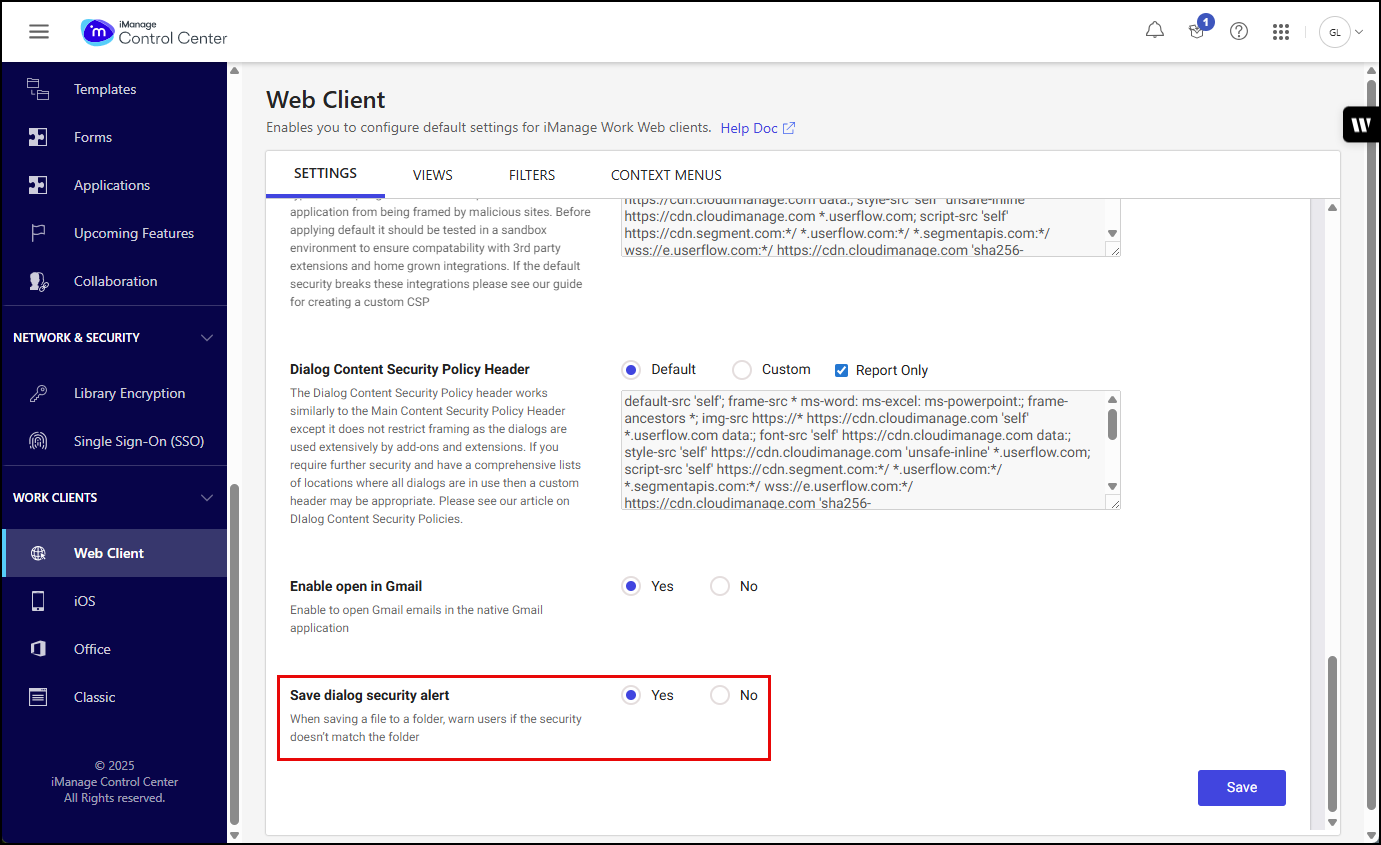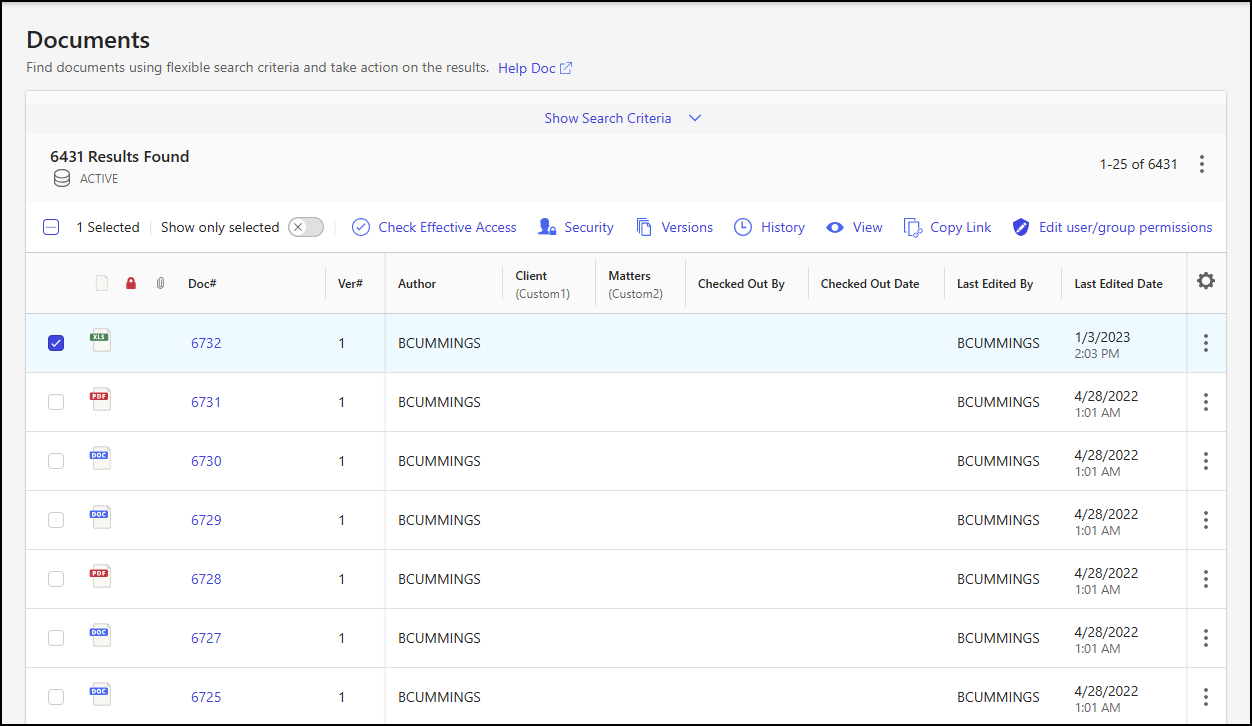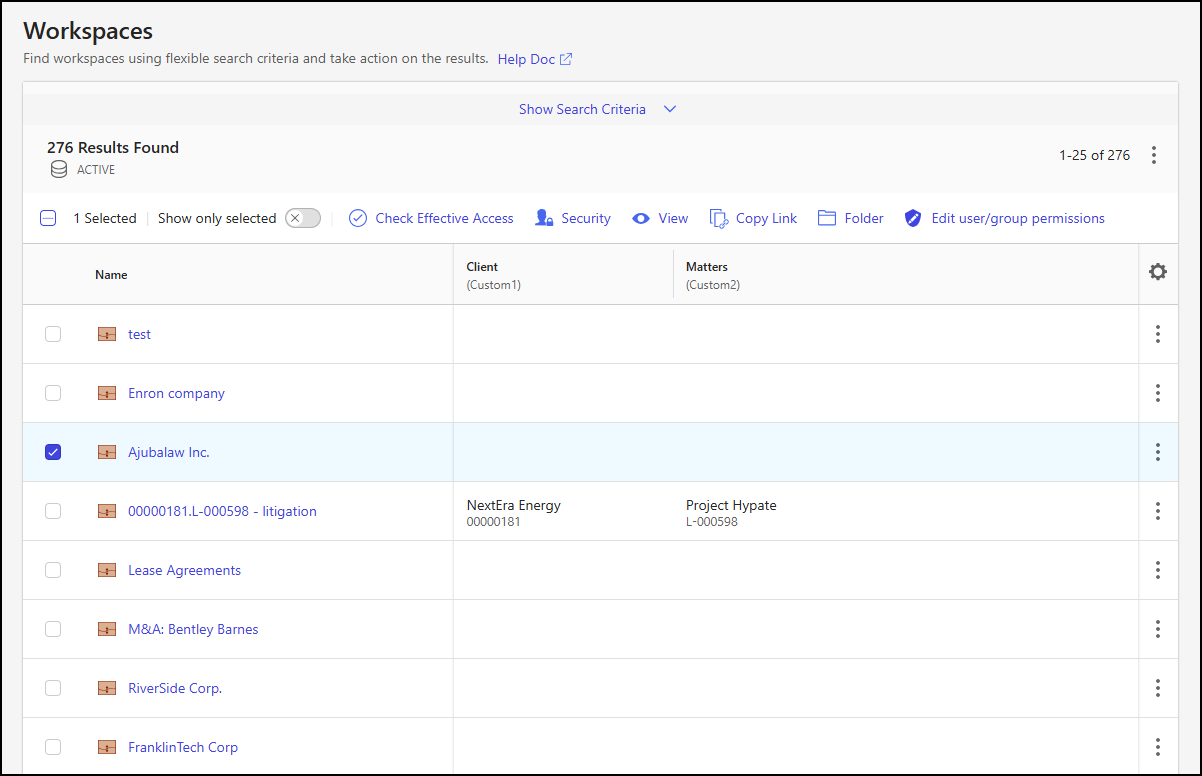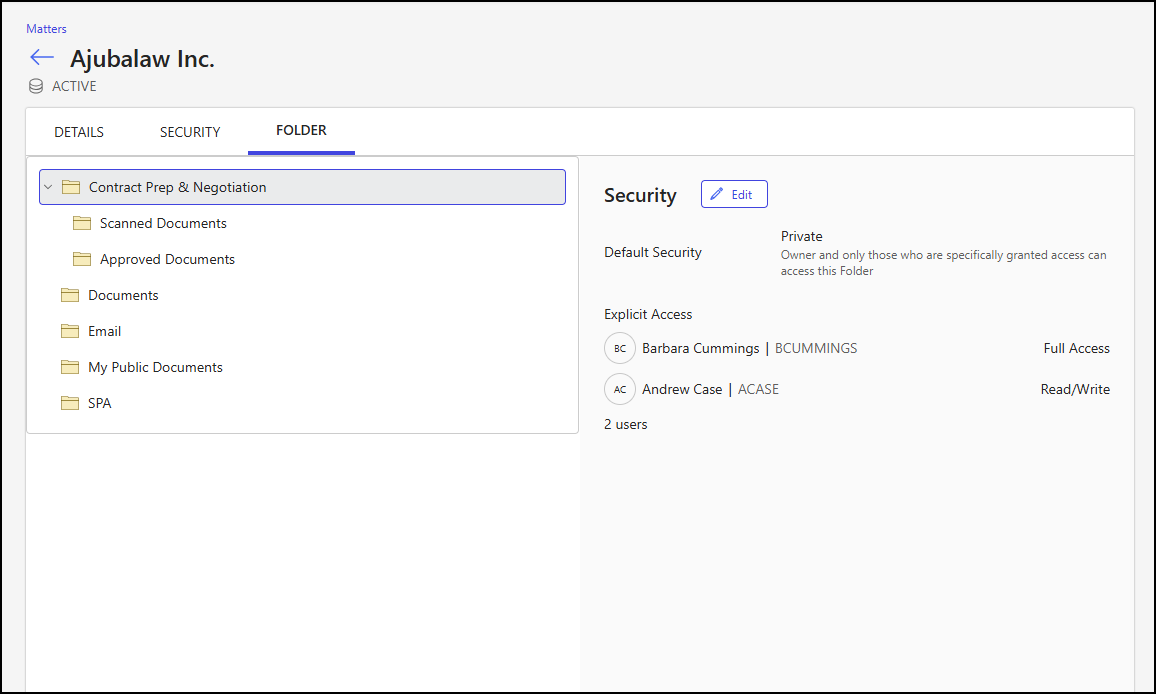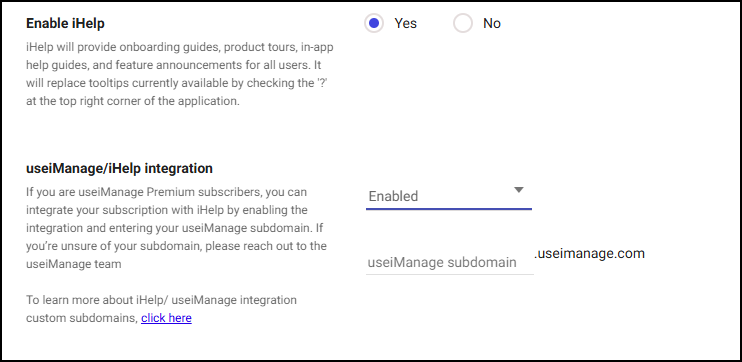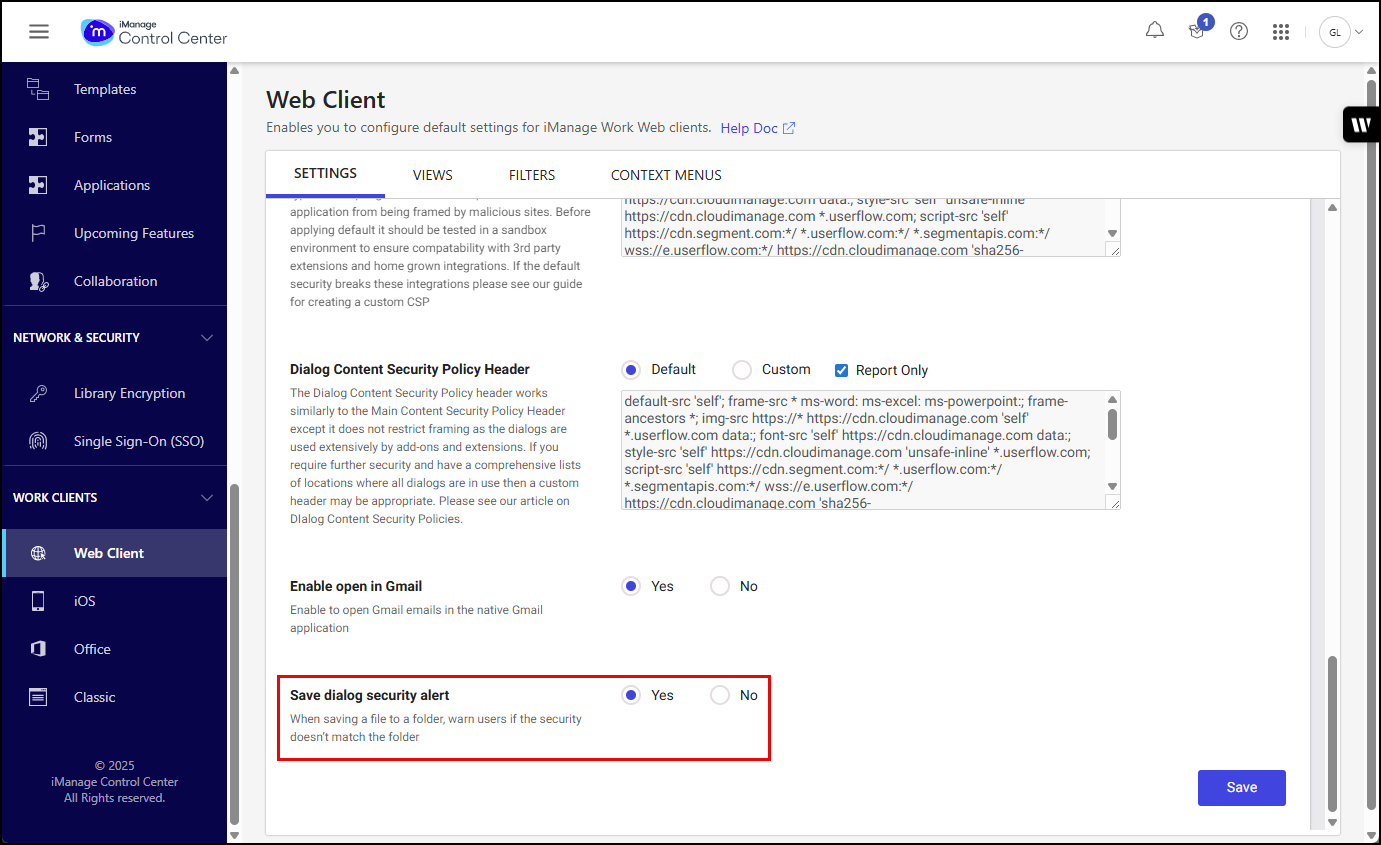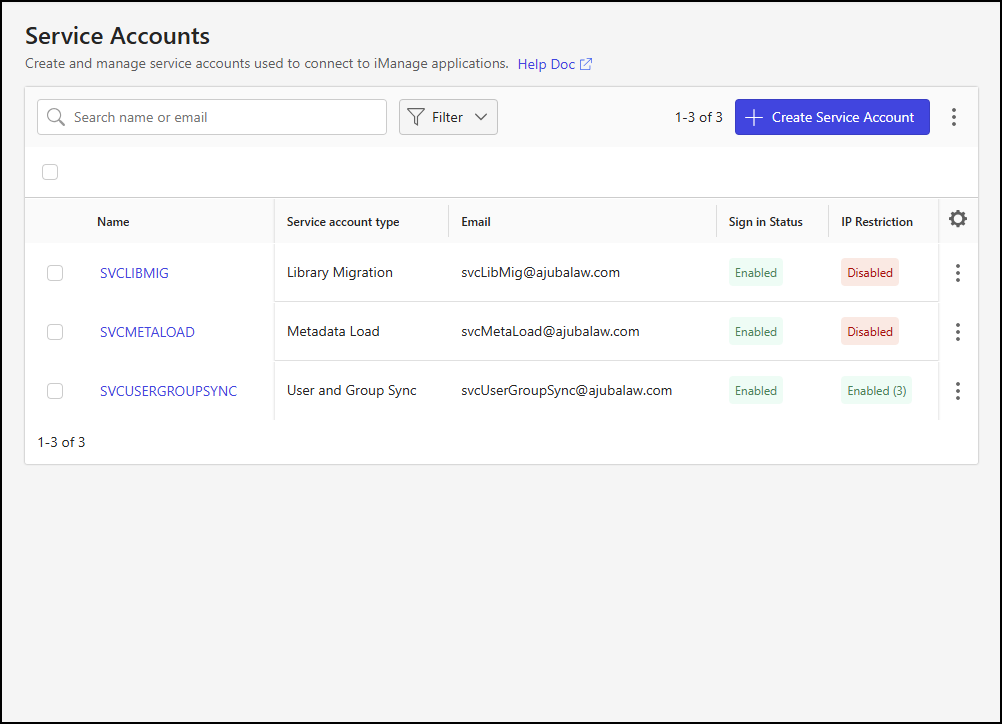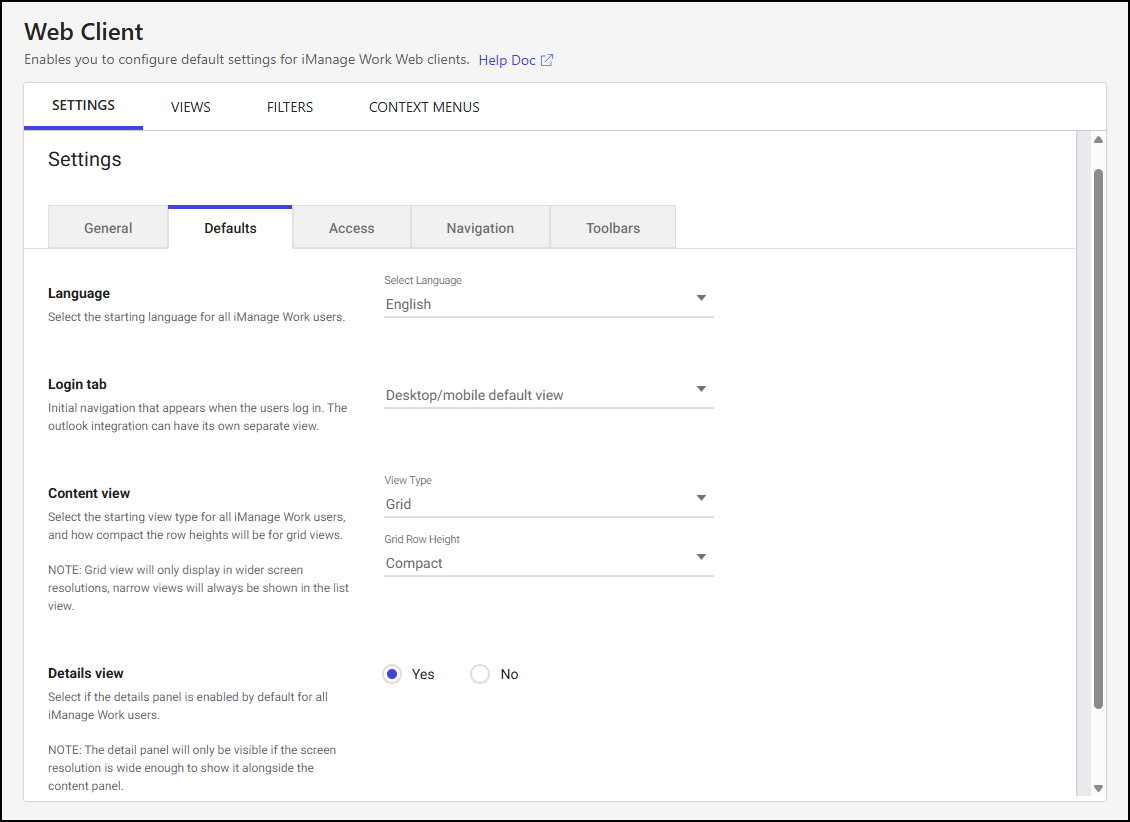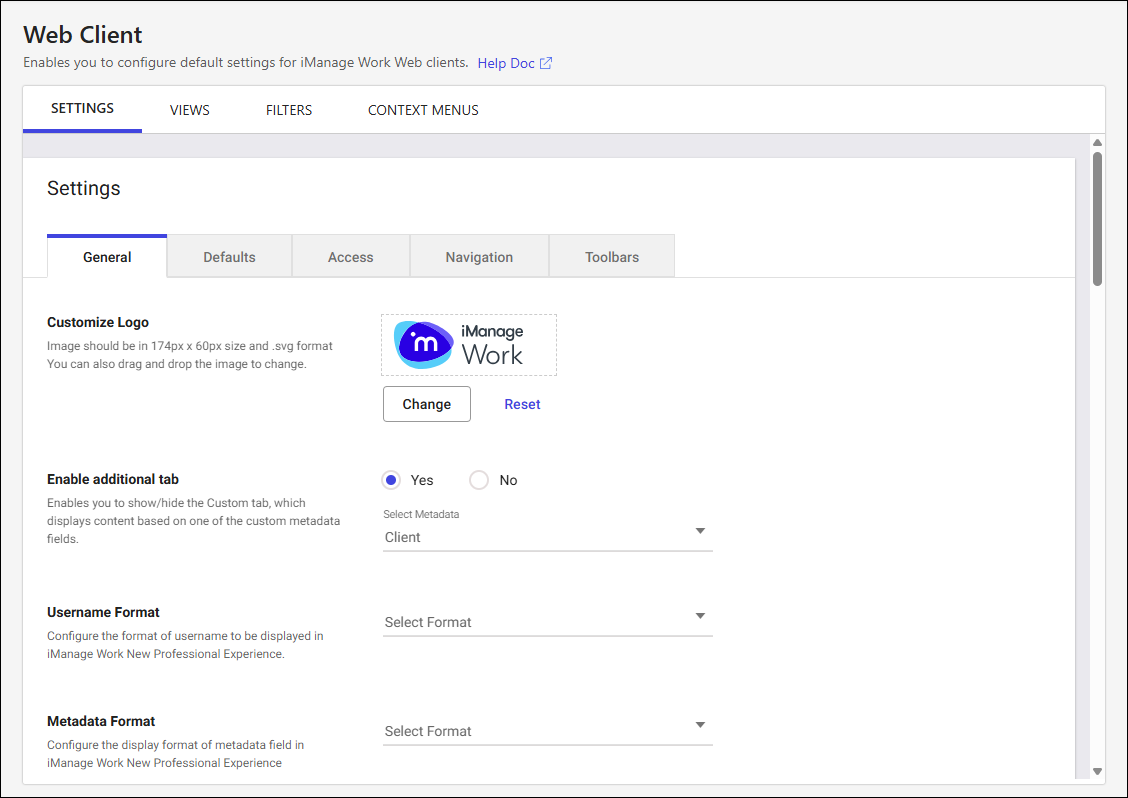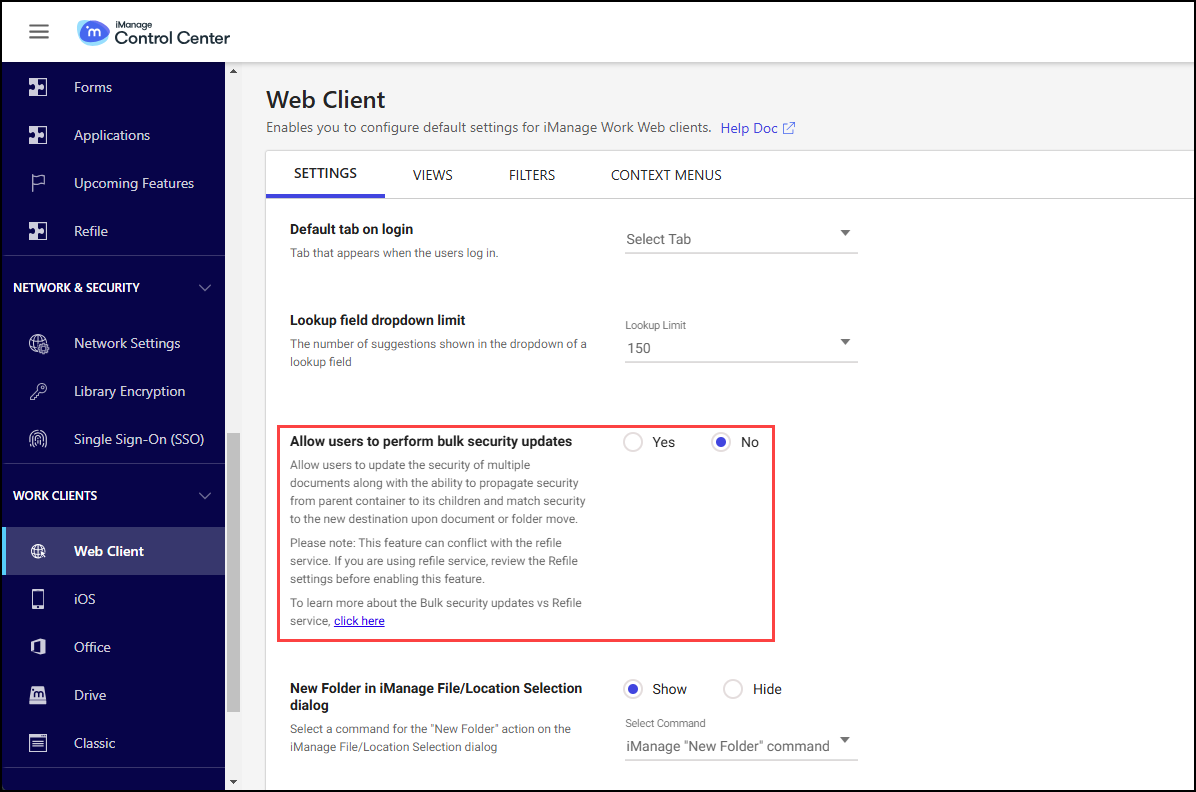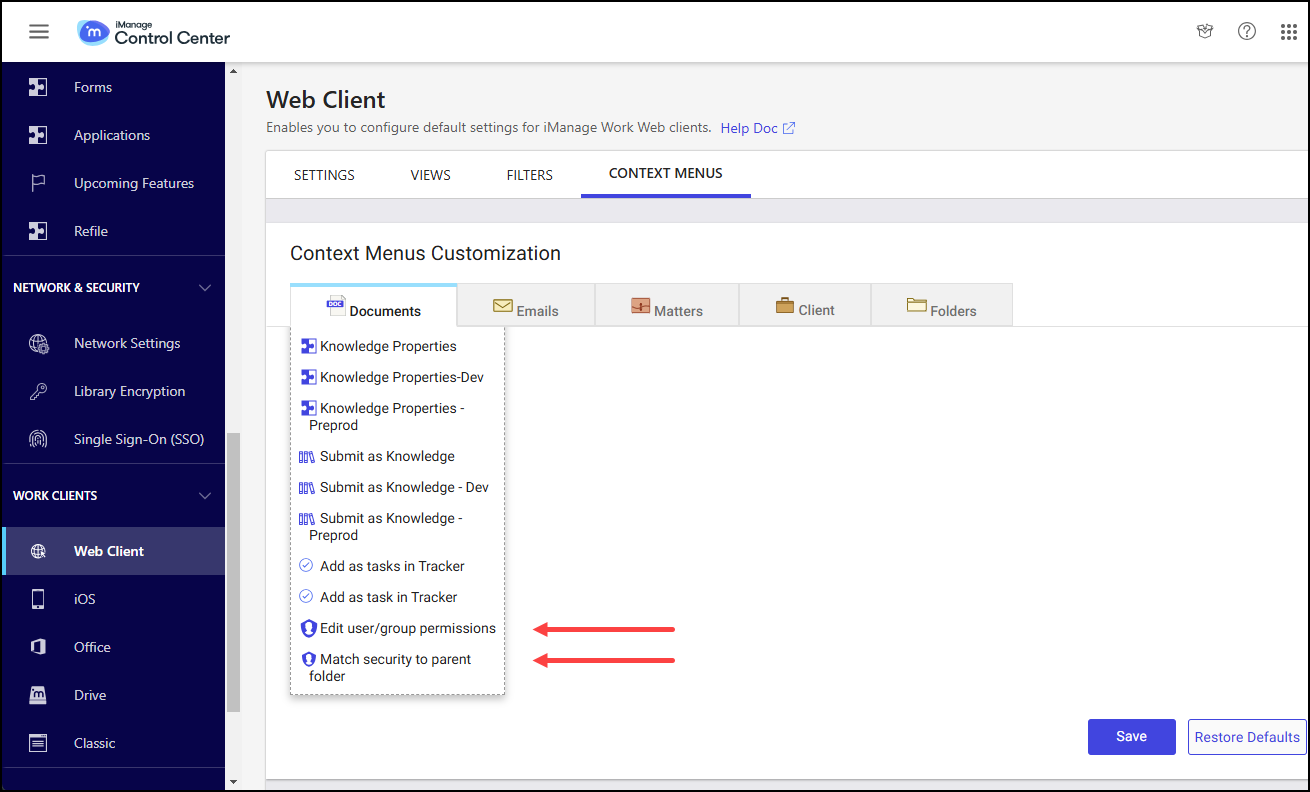New features are continuously being added to iManage Control Center. See what enhancements and feature changes are available in each update.
For features introduced in 2025 updates, refer to:
For features introduced in older updates, refer to:
November 2025
New Email context menu action
With this service update, the Copy Item action is available in the Emails context menu. This action lets users copy emails from one location to another within iManage Work. For more information about this action, refer to the Copying emails in iManage Work section of the Service update: November 2025: iManage Work at cloudimanage.com Help Center article.
When this service update is applied, one of the following scenarios will occur, depending on your setup:
If the Emails context menu is set up in the default manner:
A new Copy sub-menu is added to the context menu below the existing Print action.
The existing Copy Link action is moved to the Copy sub-menu.
The new Copy Item action is added to the Copy sub-menu.
If the Emails context menu has been customized:
The new Copy Item action is available and can be added to the Emails context menu using the Add action option.
NOTE: For instructions on configuring context menu actions, refer to Context menus.
October 2025
Configure the Save dialog security alert setting
A new configuration option has been introduced for administrators to specify if iManage Work users will receive a warning when saving a file to a folder, if the folder's security differs from the file's security settings.
To configure this setting:
In iManage Control Center, browse to Work Clients > Web Client > Settings > General.
Set the Save dialog security alert setting to meet your needs:
Yes (default): Warn users if a file's security doesn't match the folder's security setting when saving a file to the folder.
No: Don't warn users if a file's security doesn't match the folder's security setting when saving a file to the folder.
Select Save.
September 2025
HYCU for iManage Cloud
HYCU for iManage Cloud builds upon the enterprise-grade resiliency and security-by-design already inherent in iManage Cloud by offering an additional layer of control and customization for organizations with specific compliance, governance, and operational needs. The solution allows customers to maintain secure, offsite backups of their iManage Cloud Work libraries in customer-owned and managed storage, which supports internal policy data protection and disaster recovery.
Available on the HYCU Marketplace, HYCU for iManage Cloud lets administrators automate backup policies, customize retention schedules, and recover data down to the file level, including metadata and security settings. You can integrate HYCU into a broader, multi-SaaS backup strategy, all managed from a single, no-code interface.
Key benefits of HYCU for iManage Cloud include:
Customer-controlled storage for offsite backups
Policy-driven automation with “set and forget” flexibility for backup scheduling
Granular recovery of libraries, folders, documents, metadata, and permissions
Ransomware-proof backups with WORM-enabled immutable copies
HYCU for iManage Cloud is a module developed by iManage that integrates with the HYCU platform. To use HYCU for iManage Cloud, you need a subscription with HYCU. To get started using HYCU to backup your iManage Cloud data, go to https://www.hycu.com/solutions/data-protection/imanage.
Bulk security update for documents, workspaces, and folders
In the February 2025 iManage Work at cloudimanage.com service update, we introduced the ability for iManage Work users to perform bulk security updates. If you prefer that Administrators manage bulk security updates, we now provide these enhancements through iManage Control Center.
Using iManage Control Center, iManage Work administrators may now perform bulk security updates on documents, workspaces, and folders. These functionalities are accessible through the Edit user/group permissions option on the Documents and Workspaces Control Center pages, or through the Folder tab on the Workspaces page.
This enhancement gives you to flexibility to decide if all users can perform bulk security updates, or only administrators.
NOTE: To perform bulk security operations on the Documents or Workspaces pages, the user signed in to iManage Control Center must be a member of the NRTADMIN group.
Update document security
The Edit user/group permissions option lets you perform the following operations on one or more documents:
Add single or multiple users or groups, and define their access level to the selected documents.
Change the access level of existing users or groups who already have access to the selected documents, to another level of access.
Update the default security settings.
Update the security of documents referenced in multiple folders.
Update the security of all versions of documents, to which you have full access.
The option to edit user or group permissions on the Documents page is shown below.
Update workspace security
For a single workspace, the Edit user/group permissions option lets you:
Add single or multiple users or groups, and define their access level to the workspace.
Change the access level of existing users or groups who already have access to the workspace, to another level of access.
Update the default security settings.
Update the security of the contents of the workspace, including folders and documents.
Update the security of documents referenced in multiple folders.
Update the security of all versions of documents, to which you have full access.
The option to edit user or group permissions on the Workspaces page is shown below.
Update workspace folder security
In the workspace search results list, you can select a workspace to view its folder structure and the security details for each folder. Additionally, you can edit the default security settings of a folder and define access levels for users and groups.
Enable analytics setting
This update provides a new iManage Control Center setting for managing the collection of product usage information on cloudimanage.com. This allows organizations to opt out or opt in based on their organization's preferences.
To share usage analytics with iManage, follow these steps:
In iManage Control Center, browse to Settings > Global.
In the Analytics section of the Global page, select the Edit button.
In the Edit Analytics dialog, set the Enable collection of usage analytics by iManage toggle to Enabled.
Select Save.
NOTE: With this update, the existing Enable collection of search analytics by iManage option is now controlled by the Enable collection of usage analytics by iManage option. Search analytics can only be enabled if usage analytics are also enabled.
August 2025
New document version context menu action
In the February 2025 iManage Work at cloudimanage.com service update, we introduced the Enable bulk security update actions feature. This feature lets administrators grant users the option to perform bulk security updates for documents, emails, workspaces, and folders. When the feature is enabled, several actions become available on the Web Client Context Menus tab in iManage Control Center. For more details about this feature, refer to the February 2025 service update.
In addition to other capabilities, the Enable bulk security update actions feature added support for the Edit user/group permissions action on the Documents context menu. With this service update, you can now select and act on multiple versions at once in the Versions panel in iManage Work Web. This includes the option to add the Edit user/group permissions action in the Versions context menu for a document. This new action allows users to update user/group permissions for one or more versions of a document.
To add the Edit user/group permissions action in iManage Control Center, browse to Work Clients > Web Client > Context Menus. Then, follow the instructions in Context menus to add the action to the Versions context menu on the Documents tab.
Exact match search behavior change
A persistent issue exists where searches using certain combinations of query criteria lead to inexact search results. This occurs when searching for values that contain special characters in the following properties: Custom1–Custom12, Custom29–Custom30, or Author.
For example, if users search for workspaces with a Custom2 property value of 01, workspaces with values like 01–02, 01–003, and 01–03020 are also returned.
For these types of searches, users expect an exact match based on the search value they entered. Unfortunately, enforcing an exact match on these property values may impact third-party applications that rely on the current non-exact match behavior to return more inclusive results.
For this reason, we're introducing this change as an Exact Matching for Searches by Custom Aliases and Author upcoming feature. This allows you to control when to enable this behavior change in your environment. When you enable this feature in iManage Control Center, you can test the experience with your third-party applications, coordinate any changes with the third-party application providers, and communicate the behavior change to users.
This upcoming feature is available now. To ensure searches behave consistently in the future, this upcoming feature becomes permanent on November 5, 2025.
The following API endpoints are impacted by this change:
POST /work/api/v2/customers/{customerId}/libraries/{libraryId}/folders/{folderId}/children/browseGET /work/api/v2/customers/{customerId}/libraries/{libraryId}/folders/{folderId}/childrenGET /work/api/v2/customers/{customerId}/libraries/{libraryId}/workspaces/admin-searchGET /work/api/v2/customers/{customerId}/libraries/{libraryId}/templatesPOST /work/api/v2/customers/{customerId}/libraries/{libraryId}/workspaces/searchGET /work/api/v2/customers/{customerId}/libraries/{libraryId}/workspacesGET /work/api/v2/customers/{customerId}/libraries/{libraryId}/documentsPOST /work/api/v2/customers/{customerId}/libraries/{libraryId}/documents/searchGET /work/api/v2/customers/{customerId}/libraries/{libraryId}/documents/admin-searchGET /work/api/v2/customers/{customerId}/libraries/{libraryId}/recent-documentsPOST /work/api/v2/customers/{customerId}/libraries/{libraryId}/recent-documents
By default, the Exact Matching for Searches by Custom Aliases and Author feature is disabled. To enable the feature:
In iManage Control Center, browse to Settings > Upcoming Features.
Right-click Exact Matching for Searches by Custom Aliases and Author and select Enable Feature.
In the confirmation dialog, select Enable to confirm your request.
If you take no action, the Exact Matching for Searches by Custom Aliases and Author feature becomes permanent (it'll automatically be enabled) on November 5, 2025. On this date, the feature will also be removed from the Upcoming Features page in iManage Control Center.
Custom subdomain and seamless sign-in
The Custom Subdomain and Seamless Sign-in features were first introduced in the January 2023 iManage Work at cloudimanage.com service update. These features are managed by the Custom Domains upcoming feature, which is available to all customers.
Custom Subdomain: This feature lets iManage Cloud administrators create and manage a custom subdomain for their iManage Cloud URL, such as company.cloudimanage.com, to provide a customer-specific URL for users to access iManage Cloud.
Seamless Sign-in: This enhancement provides users with a more seamless sign-in experience. With single sign on (SSO) configured, users must enter their email address before being directed to your company's identity provider (IdP) for authentication. When seamless sign-in is enabled, iManage can detect your company's configured identity provider (IdP), and eliminate the need for users to enter their email address in the iManage sign-in dialog. Instead, they're automatically directed to your IdP authentication page, eliminating the need for them to enter their email address twice.
For more information about the Custom Subdomain and Seamless Sign-in features, refer to Network Settings.
You can add a custom subdomain and enable seamless sign-in after the Custom Domains upcoming feature is enabled.
By default, the Custom Domains feature is disabled. To enable the feature:
In iManage Control Center, browse to Settings > Upcoming Features.
Right-click Custom Domains and select Enable Feature.
In the confirmation dialog, select Enable to confirm your request.
If you take no action, the Custom Domains feature becomes permanent (it'll automatically be enabled) on November 5, 2025. On this date, the feature will also be removed from the Upcoming Features page in iManage Control Center.
NOTES:
When adding a custom subdomain in iManage Control Center, Admin users are prompted to review the Best practices for enabling and removing a custom subdomain for iManage Work at cloudimanage.com Help Center article. This article provides critical information describing the potential to disrupt or break other applications. Before proceeding, you must acknowledge that you’ve read the article and understand the risks.
Seamless Sign-in can be enabled only after you define a custom subdomain.
When turning on Seamless Sign-in, incorrect wording is displayed in the Enable Seamless Sign in confirmation dialog. This issue is being tracked by NT-165742.
useiManage integration with iHelp
In the November 2024 service update, we introduced iHelp, a user flow tool aimed at improving product onboarding and user guidance for iManage Work. iHelp provides on-demand access to information, improving user interactions and making task performance more straightforward. For more details about iHelp, refer to November 2024 service update.
useiManage is a subscription-based solution that delivers essential iManage content to users and admins when they need it, including:
Unlimited access to e-learning opportunities for users and administrators
Entitlements to technical and administrator certifications
Access to quick reference cards and job aids
useiManage combines eLearning, self-paced training with hands-on lab access, quick reference materials, and best practices to ensure that your team can effectively onboard and use iManage Work. For more information, refer to the useiManage registration page.
With this service update, we're letting useiManage Premium subscribers integrate their useiManage subscription with iHelp. This integration helps users to engage directly with useiManage.
To integrate useiManage with iHelp, follow these steps:
In iManage Control Center, browse to Work Clients > Web Client > Settings > General.
If not already enabled, set Enable iHelp to Yes.
Set the useiManage/iHelp integration option as follows:
Disabled: To use the standard iHelp URL.
Enabled: To integrate your useiManage subscription with iHelp.
Enter your custom useiManage subdomain.
Select Save.
For more information about these options, refer to Settings.
NOTES:
The useiManage/iHelp integration setting will display only if Enable iHelp is set to Yes.
If you’re unsure of your useiManage subdomain, contact iManage support for help.
July 2025
Configure title click and row double-click options for files
This feature lets you set different default open/edit behaviors for when an iManage Work Web user clicks the title or double-clicks the row of a Microsoft 365 file or a non-Microsoft 365 file. This separation ensures that users can perform actions relevant to each file type seamlessly within Work Web.
NOTES:
The default behavior for Microsoft 365 files applies to files with Office 365 extensions, such as .docx, .ppsx, .pptx, .xlsb, .xslm, and .xlsx.
The default behavior for non-Microsoft 365 files applies to files with legacy Microsoft Office extensions, such as .doc, .ppt, .xls, as well as other file extensions like .pdf, .txt, .zip, .png, .jpeg, and emails.
Work Web users can override the Control Center settings and customize them to suit their needs. For more information about setting user workflow preferences, refer to iManage Work Help.
New settings
The default behaviors are set in the File open options and Microsoft 365 file open options settings in iManage Control Center. To access these settings, browse to Work Clients > Web Client, and then select the Settings > Defaults tab.
The Control Center settings are described in the following table.
Table: Title click and row double-click settings
Heading name | Setting name | Option | Notes |
|---|---|---|---|
File open options This heading includes two settings (Title click and Double click) for defining the default behavior applied to non-Microsoft 365 files and legacy Microsoft Office file extensions. | Title click This setting defines the default behavior when the title of a non-Microsoft 365 file is selected. | Preview | Opens a full-screen preview of the file in iManage Work. |
Open | Opens and checks out the file or email in its native application. | ||
Open in read-only | Opens the file as read-only in its native application. | ||
Open in protected mode | Opens Microsoft Office documents in Protected View. This prevents users from accidentally leaving documents in a checked-out state. If the document isn't a Microsoft Office file, the file is opened in the native application using the Open functionality. | ||
Double click This setting defines the default behavior when the row of a non-Microsoft 365 file is double-clicked. | Preview | Opens a full-screen preview of the file in iManage Work. | |
Open | Opens and checks out the file or email in its native application. | ||
Open in read-only | Opens the file as read-only in its native application. | ||
Open in protected mode | Opens Microsoft Office documents in Protected View. This prevents users from accidentally leaving documents in a checked-out state. If the document isn't a Microsoft Office file, the file is opened in the native application using the Open functionality. | ||
None | Disables the row double-click action. | ||
Microsoft 365 file open options This heading includes two settings (Title click and Double click) for defining the default behavior applied to Microsoft 365 files. | Title click This setting defines the default behavior when the title of a Microsoft 365 file is selected. | Preview | Opens a full-screen preview of the file in iManage Work. |
Edit | Opens and checks out the file in its native application. | ||
Open in read-only | Opens the file as read-only in its native application. | ||
Open in protected mode | Opens Microsoft Office documents in Protected View. This prevents users from accidentally leaving documents in a checked-out state. | ||
Edit (Co-author) |
| ||
View in MS Office for the web |
| ||
Edit (Co-author) in MS Office for the web |
| ||
Double click This setting defines the default behavior when the row of a Microsoft 365 file is double-clicked. | Preview | Opens a full-screen preview of the file in iManage Work. | |
Edit | Opens and checks out the file in its native application. | ||
Open in read-only | Opens the file as read-only in its native application. | ||
Open in protected mode | Opens Microsoft Office documents in Protected View. This prevents users from accidentally leaving documents in a checked-out state. | ||
Edit (Co-author) |
| ||
View in MS Office for the web |
| ||
Edit (Co-author) in MS Office for the web |
| ||
None | Disables the row double-click action. |
NOTES:
For File open options, all options other than Preview require iManage Agent to be installed and configured on the user desktop.
For Microsoft 365 file open options, the Edit (Co-author) option requires iManage Work Next Generation Co-authoring to be configured. For more information on enabling Next Generation Co-authoring, refer to Configuring iManage Work Next Generation Co-authoring in iManage Control Center.
File open options setting mapping
The current File open options setting applies only when users select the title of documents and emails. This new feature extends that to include the action of double-clicking the row. Additionally, it offers separate settings for Microsoft 365 and non-Microsoft 365 files. The new settings and options are described in the New settings section.
The following table shows how default values for the existing File open options setting are mapped to the new File open options and Microsoft 365 file open options settings.
Existing default | New default for Microsoft 365 files | New default for non-Microsoft 365 files |
|---|---|---|
Preview | Preview | Preview |
Edit/Open | Edit | Open |
Open in Protected View | Open in protected mode | Open in protected mode |
View in Office for the web | View in MS Office for the web | Preview |
May 2025
Manage service accounts
A Service Account is a non-interactive account used by iManage tools and services. These accounts have scoped API access for a specific application and can't be modified for use with other applications. Service Accounts often have additional access that isn't available to interactive user accounts, such as Sync APIs, but they can't be used to sign into interactive applications like Work Web.
Before this update, service accounts could only be created by iManage personnel, and only iManage personnel could change the passwords for these accounts.
With this update, you can create and manage your organization’s iManage application service accounts without the help of iManage personnel. You can do this using the new Service Accounts page in iManage Control Center.
NOTE: Service Accounts will no longer be managed by iManage and will be self-service within Control Center.
With the new Service Accounts page, you can:
Create and update application-specific service accounts
Control the sign-in status of service accounts
Assign trusted IP address ranges to limit the sign-in locations for service accounts
Reset the authorization key assigned to a service account
NOTE: You can create service accounts for the following applications:
Library Migration: This service account type is used for Sync APIs and migration tooling.
User and Group Sync: This service account type is used for syncing users and groups with the iManage Directory Sync tool.
Metadata Load: This service account type is used to import metadata with the iManage Metadata Loader tool.
Backup and Restore: This service account type is used for syncing to iManage backup tools like HYCU.
Audit Hub Query (Beta): This service account type is used to access iManage Audit Hub APIs.
For more information about managing service accounts, refer to Service Accounts.
April 2025
Content Security Policy header
Content Security Policy (CSP) is a computer security standard designed to prevent cross-site scripting (also known as XSS), clickjacking, and other code injection attacks that result from the execution of malicious content within a trusted web page context.
The CSP header is an HTTP response header that modern browsers use to enhance the security of a document or web page. This header lets you restrict which resources, such as JavaScript, CSS, and images, that can be loaded, as well as the URLs from which they can be loaded.
This feature adds a default CSP header for iManage Work Web and lets you define a custom CSP header if you need more tailored control. You can choose to use the default header or create a custom header in iManage Control Center.
This feature offers CSP header control for the following types:
Main CSP Header: Enhances security by applying CSP to the entire Work Web application, protecting it against common scripting attacks, and preventing the application from being framed by malicious sites.
Dialog CSP Header: Offers enhanced security that’s similar to the Main Content Security Policy Header but doesn’t restrict framing, as dialogs are frequently used by add-ons and extensions.
For each CSP header type, you can use the default CSP header or define a custom CSP header for more tailored control. You can also test the default or custom CSP header rules without enforcing them to ensure that they behave as expected. These capabilities are configured using the following settings on the Web Client Settings page in iManage Control Center.
Default (default): Specifies that the default CSP header is used. When Default is selected, the default CSP header is populated automatically in the corresponding form field and can’t be modified.
Custom: Specifies that a custom CSP header is used. When Custom is selected, the corresponding form field is available for edit and a custom header must be provided.
Report Only: When this option is selected, CSP header rules are evaluated but not enforced. This lets you test CSP header settings without the risk of disrupting existing functionality. This option is selected by default.
NOTE: The default state for the main and dialog CSP headers is to use the default header and to have the report only option selected.
For more information about configuring CSP headers, refer to the Web Client Settings page and to the Content Security Policy implementations in iManage Work Web Help Center article.
Web Client Settings page updates
The Web Client Settings page in iManage Control Center is used to configure iManage Work Web settings and options. In this update, the following changes are made to the General and Features tabs of this page:
The Features tab is renamed Defaults.
The Default Language setting is renamed Language.
The Default tab on login setting is renamed Login tab.
Numerous settings are moved from the Features (now Defaults) tab to the General tab.
The Internet Explorer Warning Message setting is removed.
Two new settings, Content view and Details view, are added to the Defaults tab.
The Defaults tab and a portion of the General tab are shown in the following figures:
Settings tab name change
The Features tab on the Settings page is renamed Defaults in this update to better reflect the purpose of these settings. All settings for which an admin can configure a default option for new users are moved under this tab. Users may override these settings in iManage Work Web.
General and Defaults tab settings changes
In this update, several settings are moved from the Defaults (formerly Features) tab to the General tab, and one setting is moved from the General tab to the Defaults tab. Also, the Default Language and Default tab on login settings are renamed.
The Internet Explorer Warning Message setting is removed because Microsoft retired Internet Explorer on June 15, 2022. Users using Internet Explorer to connect to iManage Work Web will no longer see a banner recommending using a fully supported browser.
The table below summarizes the changes to the Web Client Settings page:
Table: Web Client Settings page updates
Former setting name and tab | New setting name and tab | Summary of changes | ||
|---|---|---|---|---|
Setting name | Tab | Setting name | Tab | |
Default Language | General | Language | Defaults | Setting renamed and moved |
Customize Logo | General | Customize Logo | General | No change |
Username Format | Features | Username Format | General | Setting moved |
Metadata Format | Features | Metadata Format | General | Setting moved |
Enable additional tab | Features | Enable additional tab | General | Setting moved |
Default tab on login | Features | Login tab | Defaults | Setting renamed |
Lookup field dropdown limit | Features | Lookup field dropdown limit | General | Setting moved |
Allow users to perform bulk security updates | Features | Allow users to perform bulk security updates | General | Setting moved |
New Folder in iManage File/Location Selection dialog | Features | New Folder in iManage File/Location Selection dialog | General | Setting moved |
Enable static asset delivery via Microsoft Azure's Content Delivery Network | Features | Enable static asset delivery via Microsoft Azure's Content Delivery Network | General | Setting moved |
Enable Work 10 Desktop for Windows Auto Updates App Banner | Features | Enable Work 10 Desktop for Windows Auto Updates App Banner | General | Setting moved |
Internet Explorer Warning Message | Features |
| Setting removed | |
Enable Search Language Selection | Features | Enable Search Language Selection | General | Setting moved |
Title-click operation for files | Features | Title-click operation for files | General | Setting moved |
Enable web-based email sending | Features | Enable web-based email sending | General | Setting moved |
Enable open in Gmail | Features | Enable open in Gmail | General | Setting moved |
Enable iHelp | Features | Enable iHelp | General | Setting moved |
Content view | Defaults | New setting | ||
Details view | Defaults | New setting | ||
New Default Web Client settings
The following settings are added to the Defaults tab:
Content view: Specifies the default starting view type in iManage Work Web for all users. This setting includes selections for:
View Type: Indicates the way the default starting view type is displayed:
Grid (default): Uses grid view to display items in iManage Work Web. The Grid Row Height option is displayed when this option is selected.
List: Uses list view to display items in iManage Work Web.
Grid Row Height: Specifies the density of grid rows.
Comfortable
Compact (default)
Tiny
Details view: Indicates whether the Details panel is visible by default for all iManage Work users.
Yes (default): Specifies that the Details panel is visible by default.
No: Specifies that the Details panel is hidden by default.
NOTES:
The default settings apply to users who have never changed them in iManage Work Web (such as a new user). If a user changes their settings, the user settings take precedence, even if the default settings in Control Center are changed later.
These settings don’t apply to the File Open and File Save As dialogs.
March 2025
Absolute timeout
iManage Work currently includes an idle session timeout feature for users. This capability specifies the length of time a user session can remain inactive before it’s automatically terminated. Idle session timeout can be set for each application in iManage Control Center, including software that integrates with iManage Work to access data or to add more features to an iManage Work client application. For more information about managing idle session timeout, refer to Adding an application.
This service update introduces an absolute timeout capability for iManage Work at cloudimanage.com users. This feature enhances security by automatically ending user sessions after a predefined period, regardless of user activity.
With absolute timeout, you set the maximum duration that a user session can last, regardless of whether the user is active. When the time limit is reached, the user session is terminated, and the user must re-authenticate.
NOTE: When a user session ends due to an absolute timeout, the user may not have to re-authenticate to applications that use and automatically refresh access tokens. To check if your application has refresh tokens enabled, refer to Adding an application.
Absolute timeout:
Ensures that sessions don't remain active indefinitely, even with continuous use, reducing the risk of prolonged exposure.
Helps meet regulatory requirements by enforcing regular re-authentication.
Is typically set to a longer duration (for example, 18–20 hours) to allow for a full workday session to complete before requiring re-authentication.
Configuring absolute timeout
Absolute timeout is configured using the access-token endpoint. This endpoint lets you enable and disable absolute timeout, and set the length of time before a user has to reauthenticate.
IMPORTANT: All current user access tokens are immediately revoked when the following configuration changes occur:
When the absolute timeout feature is enabled.
When the absolute timeout duration is decreased.
This revocation of user access tokens means that all iManage Work users on cloudimanage.com will need to re-authenticate to iManage Work applications when these changes are made.
For more information about absolute timeout API requests, refer to Absolute Timeout for OAuth Tokens in cloudimanage.com.
NOTE: The ability to configure absolute timeout will be added to iManage Control Center in a future update.
Support additional lookup field limits
The Lookup field dropdown limit setting in iManage Control Center configures the number of suggestions displayed in the drop-down list of iManage Work Web lookup fields. This setting was expanded in this update to include the following additional values:
500
1000
For more information about this iManage Work Web setting, refer to Settings.
February 2025
Enabling bulk security actions
A new configuration option has been introduced for administrators to allow iManage Work users to perform bulk security updates for documents, emails, workspaces, and folders. For more information about these capabilities, refer to:
Selecting multiple documents in a folder and aligning security to that of the folder
Updating folder security and applying changes to its children
NOTE: Bulk security updates applied by your users can be overwritten by the Refile Service. If you're using Refile Service to perform background security updates, we recommend you review the information in Considerations when using the Refile Service for security updates before activating this feature.
By default, these capabilities are turned off. To turn on these new capabilities for users:
Sign in to iManage Control Center and browse to Work Clients > Web Client > Settings > Features.
Set Allow users to perform bulk security updates to Yes.
Select Save.
After turning on Allow users to perform bulk security updates, the actions in the following table are available in the Context Menus tab within iManage Control Center.
NOTE: You must manually add these actions to the appropriate context menus in iManage Control Center for these workflows to be available to users. For instructions on adding these actions to the respective menus, refer to Context Menus.
Table: Context Menus
Tab | Action | Description |
|---|---|---|
Documents | Edit user/group permissions | Allows user/group permissions to be updated for one or more documents. |
Match security to parent folder | Allows for the security of one or more documents to be aligned with its parent folder. | |
Emails | Edit user/group permissions | Allows user/group permissions to be updated for one or more emails. |
Match security to parent folder | Allows for the security of one or more emails to be aligned with its parent folder. | |
Matters | Apply security to contents | Allows for workspace security settings to be propagated to its children. |
Folders | Apply security to contents | Allows for folder security settings to be propagated to its children. |
The following figure shows an example of the new actions added to the Context Menus Documents tab:
In addition to the new Context Menus actions, the following workflows are enabled in iManage Work when Allow users to perform bulk security updates is set to Yes:
The option to “Apply security changes to children” when workspace security is changed.
The option to “Apply security changes to children” when folder security is changed.
The option to “Match security to destination” when a folder(s) is moved.
The option to “Match security to destination” when a document(s) is moved.
